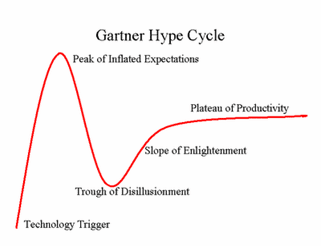Will Your Startup Beat the Hype Cycle?
The Hype Cycle was a concept put forward by Gartner, Inc. back in 1995 meant to apply to technology product evolution and acceptance. As I was reading about it recently, it occurred to me that the concept relates directly to how investors see startup opportunities and potential success as well, at least those with technology in their offerings.
For those of you unfamiliar with the concept, the Gartner Hype Cycle characterizes the over-enthusiasm or “hype” and subsequent disappointment that typically occurs with the introduction of new technologies. Hype curves then show how and when technologies move beyond the hype, offer practical benefits and become widely accepted. A hype cycle in Gartner’s interpretation always comprises five phases:
- Technology trigger. The first phase of a hype cycle is the technology trigger or breakthrough, product launch, or some other event that generates significant press and interest. This is the “truly disruptive technology” that startups often claim.
- Peak of inflated expectations. In the next phase, a frenzy of publicity typically generates over-enthusiasm and unrealistic expectations. There may be some successful applications and startups using the technology, but there are typically more failures.
- Trough of disillusionment. Technologies and related startups enter the trough of disillusionment because they fail to meet expectations and quickly become unfashionable. Consequently, the press usually abandons the topic.
- Slope of enlightenment. Although the press may have stopped covering the technology, some businesses continue through the slope of enlightenment and experiment to understand the benefits and practical application of the technology.
- Plateau of productivity. A technology reaches the plateau of productivity as the benefits of it become widely demonstrated and accepted. The technology becomes increasingly stable and evolves in second and third generations. Startups can now truly define a problem, and position their solution for rapid growth. Investors love this stage.
For the latest info, Gartner recently released their Hype Cycle Special Report, detailing some of the biggest trends in technology this year. This report evaluates the maturity of more than 1,900 technologies and trends in 89 areas. New this year are application services and outsourcing, cloud application infrastructure services, cloud security, privacy and smart cities. It’s definitely worth a look.
According to the report, private cloud computing, NFC, and Internet TV are at the moment overvalued. While, in the field of social media, social monitoring and activity streams as well as shopping communities, have moved into the Peak of Inflated Expectations. Other newly featured high-impact trends include big data and natural language question answering. Disillusionment, on the other hand, arises in the case of augmented reality.
There have been numerous criticisms of the hype cycle, one of which is that it is not a cycle and that all technologies don’t really have the same outcome. Another criticism is that the shape of the line has not altered or accelerated in ten years, even though all the evidence suggests that the half-life of new technologies is getting shorter, and the number of competing technologies is increasing.
So, of course, you have the option of ignoring hype cycle predictions and pushing forward with your latest technology startup. Just don’t be surprised if you get investor pushback while early in the cycle, and be prepared with counter arguments. Great startups always beat the hype.

